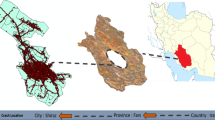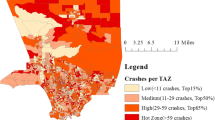Abstract
The rapid expansion of road construction and ever-increasing growth of urbanization have led to increased number of vehicles. Achieving the safe trips without personal harm or property damage has always been the concern of safety specialists. Over the last few years, the safety researchers attempted to develop the innovative methodologies to explore the crash affecting factors and obtain practical models with high prediction power. Generalized Linear Models (GLMs) with Poisson or Negative Binomial distribution of errors are known as the most common techniques to investigate the relationship between crashes and the related factors. Such models assume the dependent variable (e.g. crash frequency or crash rates) to be statistically independent. However; spatial traffic accidents have the tendency to be dependent, a phenomenon known as spatial autocorrelation. Values over distance are more or less similar than expected for randomly associated observations. This study aims to develop a series of crash prediction models based on Traffic Analysis Zone (TAZ)-level crashes and contributing associated factors using GLMs and spatial semi-local Poisson-Gamma-CAR model. Trip generation variables will be employed as the surrogate variable for land use and demographic characteristics in models in addition to network variables and traffic volume. The significant Moran’s I as the spatial autocorrelation indicator performing on crash frequencies grouped in 253 TAZs in Mashhad, Iran and the same analysis for residuals of all models proved the reliability of spatial model over conventional GLMs. The spatial model also indicated an improvement in model performance as indicated by the set of goodness-of-fit criteria. The results of local analysis can provide a predictive tool at the planning-level which can be applied on different travel demand policies to evaluate their traffic safety impacts.

Similar content being viewed by others
References
Abdel-Aty, M., & Keller, J. (2005). Exploring the overall and specific crash severity levels at signalized intersections. Accident Analysis and Prevention, 37(3), 417–425.
Abdel-Aty, M., & Radwan, A. E. (2000). Modeling traffic accident occurrence and involvement. Accident Analysis and Prevention, 32(5), 633–642.
Aguero-Valverde, J., & Jovanis, P. P. (2006). Spatial analysis of fatal and injury crashes in Pennsylvania. Accident Analysis and Prevention, 38(3), 618–625.
Amoros, E., Martin, J. L., & Laumon, B. (2003). Comparison of road crashes incidence and severity between some French counties. Accident Analysis and Prevention, 35(4), 537–547.
Anastasopoulos, P. C., Tarko, A. P., & Mannering, F. L. (2008). Tobit analysis of vehicle accident rates on interstate highways. Accident Analysis and Prevention, 40(2), 768–775.
Anselin, L. (1988). Spatial econometrics:methods and models. Boston: Kluwer Academic Publication.
Anselin, L. (1995). Local indicators of spatial association – LISA. Geographical Analysis, 27(2), 93–115.
Bertazzon, S., Olson, S., & Knudtson, M. K. (2010). A Spatial Analysis of the Demographic and Socio-economic Variables Associated with Cardiovascular Disease in Calgary (Canada). Applied Spatial Analysis and Policy, 3(1), 1–23.
Besag, J. (1974). Spatial interaction and the statistical analysis of lattice systems. Journal of the Royal Statistical Society: Series B: Methodological, 36(2), 192–236.
Boarnet, M., & Crane, R. (2001). The influence of land use on travel behavior: specification and estimation strategies. Transportation Research Part A: Policy and Practice, 35(9), 823–845.
Bone, C., Wulder, M. A., White, J. C., Robertson, C., & Nelson, T. A. (2013). A GIS-based risk rating of forest insect outbreaks using aerial overview surveys and the local Moran’s I statistic. Applied Geography, 40, 161–170.
Caliendo, C., Guida, M., & Parisi, A. (2007). A crash-prediction model for multilane roads. Accident Analysis and Prevention, 39(4), 657–670.
Cameron, C., Trivedi, K., & Parvin (1998). Regression Analysis of Count Data (Econometric Society Monographs). Cambridge: Cambridge University Press.
Carnes, A., & Ogneva-Himmelberger, Y. (2012). Temporal Variations in the Distribution of West Nile Virus Within the United States; 2000–2008. Applied Spatial Analysis and Policy, 5(3), 211–229.
Chatterjee, A., Everett, J. D., Reiff, B., Schwetz, T., Seaver, W., & Wegmann, F. J. (2003). Tools for assessing safety impact of long-range transportation plans in urban areas. Paper presented at the 80th Annual Meeting of the Transportation Research Board, TRB, Washington, DC
Clark, D., & Cushing, B. M. (2004). Rural and urban traffic fatalities, vehicle miles, and population density. Accident Analysis and Prevention, 36(6), 967–972.
Conley, J. E., Stein, R., & Davis, C. (2014). A Spatial Analysis of the Neighborhood Scale of Residential Perceptions of Physical Disorder. Applied Spatial Analysis and Policy, 7(2), 183–201.
de Guevara, F. L., Washington, S., & Oh, J. (2004). Forcasting carshes at the planning level: simultaneous negative binomial crash model applied in Tucson, Arizona. Transportation Research Record, 1897, 191–199, doi:10.3141/1897-25.
Eksler, V. (2008). Exploring spatial structure behind the road mortality of regions in europe. Applied Spatial Analysis and Policy, 1(2), 133–150.
Eksler, V., & Lassarre, S. (2008). Evolution of road risk disparities at small-scale level: Example of Belgium. Safety Research, 39, 417–427.
Elias, W., Toledo, T., & Shiftan, Y. (2010). The effect of daily-activity patterns on crash involvement. Accident Analysis and Prevention, 42(6), 1682–1688.
Erdogan, S. (2009). Explorative spatial analysis of traffic accident statistics and road mortality among the provinces of Turkey. Safety Research, 40(5), 341–351.
Ewing, R., & Cervero, R. (2010). Travel and the built environment. Journal of the American Planning Association, 76(3), 265–294.
Fotheringham, S., Charlton, M., & Brundson, C. (2002). Geographically Weighted Regression:. Wiley.
Fridstrom, L., & Ingebrigtsen, S. (1991). An aggregate accident model based on pooled, regional time-series data. Accident Analysis and Prevention, 23(5), 363–378.
Hadayeghi, A., Shalaby, A. S., & Persaud, B. N. (2003). Macro-level accident prediction models for evaluating safety of urban transportation systems. Transportation Research Record, 1840, 87–95.
Hadayeghi, A., Shalaby, A. S., Persaud, B. N., & Cheung, C. (2006). Temporal transferability and updating of zonal level accident prediction models. Accident Analysis and Prevention, 38(3), 579–589.
Hadayeghi, A., Shalaby, A. S., & Persaud, B. N. (2010). Development of planning level transportation safety tools using Geographically Weighted Regression. Accident Analysis and Prevention, 42(2), 676–688.
Levine, N., Kim, K. E., & Nitz, L. H. (1995). Spatial Analysis of Honolulu motor vehicle crashes:Zonal generators. Accident Analysis and Prevention, 27(5), 675–685.
Levine, N., Lord, D., & Park, B.-J. (2010). CrimeStat Version 3.3 Update Notes:Part 2: Regression Modeling.
Li, Z., Knight, S., Cook, L. J., Hyde, L. K., Holubkov, R., & Olson, L. M. (2008). Modeling motor vehicle crashes for street racers using zero-inflated models. Accident Analysis and Prevention, 40(2), 535–839.
Lord, D. (2006). Modeling motor vehicle crashes using Poisson-gamma models: examining the effects of low sample mean values and small sample size on the estimation of the fixed dispersion parameter. Accident Analysis & Prevention, 38(4), 751–766.
Lord, D., Washington, S., & Ivan, J. (2005). Poisson, Poisson-gamma and zero-inflated regression models of motor vehicle crashes: balancing statistical fit and theory. Accident Analysis and Prevention, 37(1), 35–46.
Lord, D., Washington, S., & Ivan, J. (2007). Further notes on the application of zero-inflated models in highway safety. Accident Analysis and Prevention, 39(1), 53–57.
Lovegrove, G. R., & Litman, T. A. (2008). Macrolevel Collision Prediction Models to Evaluate Road Safety Effects of Mobility Management Strategies: New Empirical Tools to Promote Sustainable Development. Paper presented at the Transportation Research Board 87th Annual Meeting, Washington DC.
Lovegrove, G. R., & Sayed, T. (2006). Macro-level collision prediction models for evaluating neighbourhood traffic safety. Canadian Journal of Civil Engineering, 33(5), 609–621.
McCullagh, P., & Nelder, J. (1989). Generalized Linear Models (Second ed.). London: Chapman and Hall.
Miaou, S. P. (1994). The relationship between truck collisions and geometric Design of Road Sections:Poisson versus negative binomial regression. Accident Analysis & Prevention, 26, 471–482.
Miaou, S.-P. (2003). Modeling Traffic Crash-Flow Relationships for Intersections: Dispersion Parameter, Functional Form, and Bayes Versus Empirical Bayes Methods. Transportation Research Record, 1840, 31–40.
Miaou, S.-P., & Song, J. J. (2005). Bayesian ranking of sites for engineering safety improvements: decision parameter, treatability concept, statistical criterion, and spatial dependence. Accident Analysis & Prevention, 37, 699–720.
MTTO (2007). Comprehensive Transportation Studies of Mashhad City, Mashhad Transportation and Traffic Organization (MTTO).
Naderan, A., & Shahi, J. (2010). Aggregate crash prediction models: Introducing crash generation concept. Accident Analysis and Prevention, 42(1), 339–346.
Noland, R. (2003). Traffic Fatalities and Injuries: The Effect of Changes in Infrastructure and Other Trends. Accident Analysis and Prevention, 35(4), 599–611.
Noland, R., & Oh, L. (2004). The effect of infrastructure and demographic change on traffic-related fatalities and crashes: a case study of Illinois county-level data. Accident Analysis and Prevention, 36(4), 525–532.
Noland, R., & Quddus, M. A. (2004). A spatially disaggregate analysis of road casualities in England. Accident Analysis and Prevention, 36(6), 937–984.
O’Sullivan, D., & Unwin, D. (2002). Geographic Information Analysis:. Hoboken: Wiley.
Porat, I., Shoshany, M., & Frenkel, A. (2012). Two Phase Temporal-Spatial Autocorrelation of Urban Patterns: Revealing Focal Areas of Re-Urbanization in Tel Aviv-Yafo. Applied Spatial Analysis and Policy, 5(2), 137–155.
Qin, X., Ivan, J. N., & Ravishanker, N. (2004). Selecting exposure measures in crash rate prediction for two-lane highway segments. Accident Analysis & Prevention, 36, 183–191.
Quddus, M. A. (2008). Modelling area-wide count outcomes with spatial correlation and heterogeneity: An analysis of London crash data. Accident Analysis and Prevention, 40(4), 1486–1497.
Shariat-Mohaymany, A., Shahri, M., Mirbagheri, B., & Matkan, A. A. (2015). Exploring spatial non-stationarity and varying relationships between crash data and related factors using geographically weighted poisson regression. Transactions in GIS, 19(2), 321–337.
Siddiqui, C., Abdel-Aty, M., & Choi, K. (2012). Macroscopic spatial analysis of pedestrian and bicycle crashes. Accident Analysis and Prevention, 45, 382–391. doi:10.1016/j.aap.2011.08.003.
Wang, Y., & Kockelman, K. M. (2013). A Poisson-lognormal conditional-autoregressive model for multivariate spatial analysis of pedestrian crash counts across neighborhoods. Accident Analysis & Prevention, 60, 71–84.
Washington, S., Karlaftis, M. G., & Mannering, F. L. (2003). Statistical and Econometric Methods for Transportation Data Analysis. Boca Raton: Chapman & HALL/CRC.
Washington, S., Schalwyk, I. V., & Mitra, S. (2006). Incorporating Safety into Long-Range Transportation Planning. Washington, DC: Transportation Research Board of the National Academies.
Wier, M., Weintraub, J., Humphrey, E. H., Seto, E., & Bhatia, R. (2009). An area-level model of vehicle-pedestrian injury collisions with implications for land use and transportation planning. Accident Analysis and Prevention, 41(1), 137–145.
Acknowledgments
The authors wish to extend their very special thanks and appreciation to Dr. Ali Naderan for his relentless genuine collaboration in providing the data.
Author information
Authors and Affiliations
Corresponding author
Rights and permissions
About this article
Cite this article
Shariat-Mohaymany, A., Shahri, M. Crash Prediction Modeling Using a Spatial Semi-Local Model: A Case Study of Mashhad, Iran. Appl. Spatial Analysis 10, 565–584 (2017). https://doi.org/10.1007/s12061-016-9199-x
Received:
Accepted:
Published:
Issue Date:
DOI: https://doi.org/10.1007/s12061-016-9199-x




